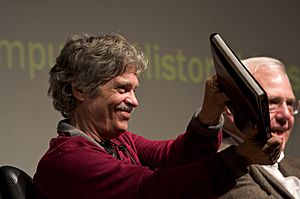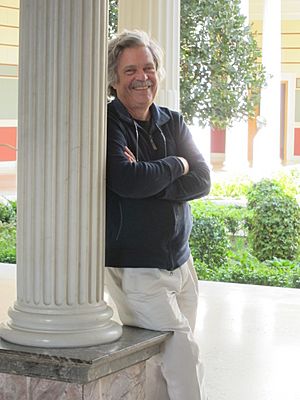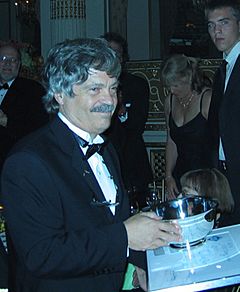Alan Kay facts for kids
Quick facts for kids
Alan Kay
|
|
|---|---|

Alan Kay holding the prototype of the Dynabook
|
|
| Born |
Alan Curtis Kay
May 17, 1940 |
| Education | University of Colorado, Boulder (BS) University of Utah (MS, PhD) |
| Known for | Dynabook Object-oriented programming Smalltalk Desktop metaphor Graphical user interface Windows |
| Spouse(s) | Bonnie MacBird |
| Awards | ACM Turing Award (2003) Kyoto Prize Charles Stark Draper Prize |
| Scientific career | |
| Fields | Computer science |
| Institutions | Xerox PARC Stanford University Atari Inc. Apple Inc. ATG Walt Disney Imagineering UCLA Kyoto University MIT Viewpoints Research Institute Hewlett-Packard Labs |
| Thesis | FLEX: A Flexible Extendable Language (1968) |
| Doctoral advisors | David C. Evans Robert S. Barton |
| Notable students | David Canfield Smith |
Alan Curtis Kay (born May 17, 1940) is an American computer scientist. He is famous for his big ideas that changed how we use computers today. He helped create object-oriented programming and the graphical user interface (GUI).
At Xerox PARC, he led the team that designed the first modern computer desktop. This is the screen you see when you turn on your computer, with icons and windows. He also helped create the Smalltalk programming language. He even came up with the term "object-oriented" for this new way of programming.
Alan Kay has received many important awards for his work. These include the Turing Award in 2003, which is like the Nobel Prize for computer science.
Early Life and Learning
Alan Kay was born in Springfield, Massachusetts. His family moved around a lot because of his father's job. They eventually settled in the New York metropolitan area.
He was a very smart kid who learned to read at a young age. He once said that by the time he started first grade, he had already read about 150 books!
Education and Military Service
Kay went to Brooklyn Technical High School. After that, he attended Bethany College. There, he studied biology and mathematics.
He then taught guitar for a year. Later, he joined the United States Army. He became a computer programmer in the United States Air Force.
After his time in the military, he went to the University of Colorado Boulder. He earned a degree in mathematics and molecular biology in 1966.
Graduate Studies and Early Inventions
In 1966, Alan Kay started graduate school at the University of Utah College of Engineering. He earned two advanced degrees in computer science. In 1969, he completed his PhD. His main project was inventing a computer language called FLEX.
While at Utah, he worked with important people in computer graphics. These included David C. Evans and Ivan Sutherland. Sutherland's ideas about computer objects really influenced Kay's thinking.
In 1968, he met Seymour Papert. He learned about the Logo programming language, which was made for education. This led him to study how children learn. He also saw a famous computer demonstration by Douglas Engelbart. This event, known as "The Mother of All Demos," greatly inspired Kay.
In 1970, Kay joined the Xerox PARC research team. There, he spent the next ten years developing early versions of networked computers. He used the Smalltalk programming language for these projects.
The Idea of Object-Oriented Programming
Alan Kay and his colleagues at PARC are known as the "fathers" of object-oriented programming (OOP). This is a way of organizing computer programs using "objects." These objects can send "messages" to each other.
Kay once said that the most important idea was "messaging," not just the "objects" themselves. This way of thinking made computer programs much easier to build and understand.
The Dynabook and Modern Computers
While at PARC, Alan Kay came up with the idea for the Dynabook. This was a concept for a personal computer that would be small and portable. It was a very early idea for what we now call laptop and tablet computers. It also inspired the e-book.
He also designed the modern graphical user interface (GUI) with overlapping windows. This is how you see different programs open on your computer screen today. Because the Dynabook was meant for learning, Kay is also seen as one of the first people to research mobile learning. Many of his ideas are used in the One Laptop Per Child project.
Later Work and Projects
After leaving PARC, Alan Kay continued to work on new computer ideas.
From 1981 to 1984, he was the Chief Scientist at Atari. Then, in 1984, he joined Apple Inc. as an Apple Fellow. Later, he worked at Walt Disney Imagineering, helping with research and development.
In 2001, Kay started the Viewpoints Research Institute. This was a non-profit group focused on children, learning, and advanced software. He led the Institute until it closed in 2018. He also worked at HP Labs and taught at several universities.
Squeak, Etoys, and Croquet
In 1995, Alan Kay helped create Squeak, an open source version of Smalltalk. His team also developed Etoys, a system that helps children learn to program.
More recently, he helped start the Croquet Project. This is an open-source system for working together in 2D and 3D online environments.
The Children's Machine
In 2005, the MIT introduced a new laptop for education around the world. It's known as the One Laptop per Child program or the XO-1. This project was inspired by Kay's Dynabook idea. Alan Kay is a key part of this project, focusing on the educational software using Squeak and Etoys.
Reinventing Programming
Alan Kay often talks about how the computer revolution is still very new. He believes there are many more good ideas to discover and use. He thinks that computer programs today are too complicated. He wants to find ways to make them much simpler and easier to understand.
Personal Life
Alan Kay has many talents outside of computer science. He used to be a professional jazz guitarist. He is also a composer and a theatrical designer. He enjoys playing the classical pipe organ as a hobby.
Awards and Honors
Alan Kay has received many important awards for his contributions to computer science:
- UdK 01-Award in Berlin, Germany, for his work on the GUI.
- NEC C&C Prize (2001).
- Telluride Tech Festival Award of Technology (2002).
- ACM Turing Award (2003) for his work on object-oriented programming and personal computing.
- Kyoto Prize (2004).
- Charles Stark Draper Prize (2004) with Butler W. Lampson, Robert W. Taylor, and Charles P. Thacker.
- UPE Abacus Award (2012) for supporting students in computing.
He has also received many honorary doctorates from universities around the world. He is an elected fellow of several important organizations, including:
- American Academy of Arts and Sciences
- National Academy of Engineering (1997) for inventing the idea of portable personal computing.
- Royal Society of Arts
- Computer History Museum (1999) for his work on personal computing and human-computer interfaces.
- Association for Computing Machinery (2008) for his work on personal computing and object-oriented programming.
- Hasso Plattner Institute (2011).
His other honors include the J-D Warnier Prix d'Informatique, the ACM Systems Software Award, and the ACM SIGCSE Award for Outstanding Contributions to Computer Science Education.
See also
 In Spanish: Alan Kay para niños
In Spanish: Alan Kay para niños




